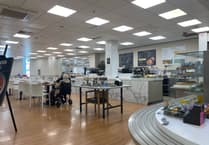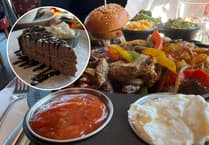From Friday, July 4 to Tuesday, July 8, St Andrew’s United Reformed Church, which is adjacent to St Ninian’s Church, will be promoting a special flower festival to celebrate its 200th year.
The celebrations will also feature a summer concert of light entertainment with the wonderful Manx Voices, led by musical director Angela Stewart, on Friday, July 4 at 7.30pm, with free entry.
Refreshments will be available and a raffle will take place. Over the festival days, magnificent floral displays by Linda Jackson and members of the congregation will be on show.
A special service to celebrate the 200-year anniversary was held on March 16. I had no idea the church had been reaching out to our community for so long, and there is an interesting history, some aspects of which I share here.
The congregation that was to become St Andrew’s Presbyterian Church first met in an upper room in Fort Street on March 20, 1825.
At this meeting, it was decided that collections would be undertaken with the objective of fitting up proper church premises.
These efforts were clearly successful, as the first service in the newly constructed building at the end of Finch Road was held on the last Sunday of April 1832.
The building was altered in 1867, and that is the way many people in Douglas remember ‘Old St Andrew’s’.
The beginning of the second century of the church was a period of prosperity for St Andrew’s.
Despite being a large building, the congregation was outgrowing the Finch Road site and an extension was needed.
In 1929, whilst many around the world were losing money in the Wall Street Crash, St Andrew’s was making a quick buck or two by holding a three-day bazaar at the Villa Marina.
Rev Hunter Wray presided over it, and the Lieutenant Governor and Lady Hill attended. A young member of the Sunday School, named Jessie Harvey, presented a bouquet to Mrs Cunningham, the head of the Sunday School.
In 1932, Rev Hunter Wray was called back to ministry in Scotland, and this led to a unique appointment for the church: former professional footballer James Jackson took the reins.
Born a Geordie but with Scottish parents, Rev Jackson played 224 times for Liverpool.
During his time, the Sunday School waved goodbye to long-time superintendent William Cunningham - a man who had overseen a huge growth in numbers, financing part of the building himself. He is remembered fondly in the island for Cunningham’s Camp on Victoria Road, one of the island’s great tourist attractions.
Over the years, the church was not short of distinguished island residents in its membership, including J.D. Bolton, who between 1967 and 1977 was the island’s chairman of the Finance Board, which led to significant economic development under his stewardship. Another prominent member was Norman McDonald, the treasurer of Douglas Town Council.
In the pre-war years, the church was buoyant, with a congregation that increased from 230 to 280 by 1936.
The declaration of war served to further increase the numbers, with many members of the armed forces attending each week.
The church was used every day, with activities such as the church badminton club, choir practice, and the Christian Endeavour Club all regular users. The Women’s Workers Party (which I had not heard of but will look into in the future) and the Scouts also held meetings.
The post-war period saw continuing thriving congregations. In the 1950s, two new preachers arrived: Rev Wilfred Robinson and Rev Fred Mitchell. The changing role of women in society was reflected in the church.
Jessie Harvey - the little girl who gave the bouquet at the Villa Marina - became the first female elder on December 27, 1964, paving the way for many more to follow. Whilst she was inducted alongside five men, a glass ceiling had been broken, and the church would forever be better for it.
In 1972, the creation of the United Reformed Church introduced a more ecumenical approach to worship. In 1977, the youngest ever elder, Brian Richardson, became church secretary - a position he held for 30 years.
The 1980s were dominated by Thatcherism, with a greatly increased emphasis on self, which impacted church attendances across the island. The large church building and greater running costs led to financial pressures. With a smaller congregation, the elders looked for pastures new.
A charismatic new Scotsman arrived, and he is still spoken of with great fondness today: Rev Leslie Guthrie. Initially, consideration was given to a merger with Finch Hill, but it soon became apparent that it too needed much financial repair. The wish list was for something smaller, more modern, and with adequate parking.
Wilma Prentice was a dynamic Sunday School leader and an important member of the local Girl Guide scene. As a trustee of the Scout and Guide Headquarters at the top of Bray Hill, she had heard that the building was for sale - but only to a worthy cause. Rev Guthrie toured the site, recognised its potential, and the elders successfully purchased it in 1988. In a poignant turn of events, the Scout Hall was named after William Cunningham - the very same man who had led the Sunday School renovations in 1932.
Sadly, the Finch Road site had deteriorated and was no longer fit for purpose. So, in advance of securing the new building on Glencrutchery Road, its last emotional service was held on June 28, 1987, and the church took up temporary residence in St George’s Hall in Finch Road.
Meanwhile, renovations took place at the new premises, which were dedicated on April 21, 1989. The rest is history, with a memorial garden recognising many of those who helped save the church through turbulent times. Inside is a plaque that pays tribute to Lenny Uren, the church organist for 30 years.
The new church building led to a vibrant social life, and a ‘St Andrew’s Social Committee’ was established in 1987, with founder members including Wilma Prentice, Pauline Richardson, Val Bathgate, Elan Karran, Pat Robertson, Muriel Michelson, and Sandie Newson - who kindly provided much of the information for this piece.
The final member was Rev Leslie Guthrie, who was apparently there to keep the ladies in order!
The committee organised a wide range of fundraising events including a Burns Night, St Andrew’s Day lunches, summer concerts, Christmas and summer fayres, quizzes, and treasure hunts—all to raise money for the church.
In the 1990s, a new initiative to sell tea, coffee, and chocolate bars to TT fans began. This has since expanded and now raises thousands of pounds for the church. Indeed, at TT 2025, they filled, wrapped, and labelled 1,850 baps, and sliced and served around 1,400 pieces of homemade cakes, shortbread, and cookies—provided by 22 different home bakers ranging in age from teenagers to those in their 80s!
In 2013, Rev Dawn Mather became the first female leader of the church in its long history.
New ideas such as ‘messy church’ have continued to develop over the years. Well done to all concerned, and if you have spare time between July 4-8, pop in and spend some time with all those dedicated to its future success.
.png?width=455)

.png?width=209&height=140&crop=209:145,smart&quality=75)

.jpeg?width=209&height=140&crop=209:145,smart&quality=75)